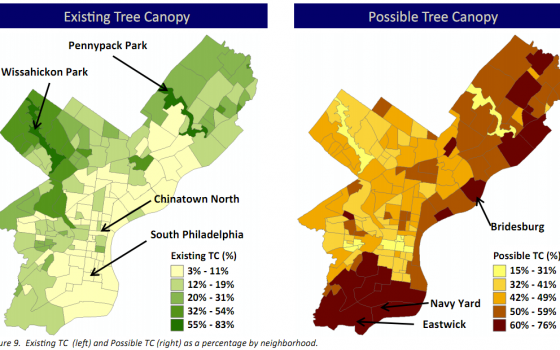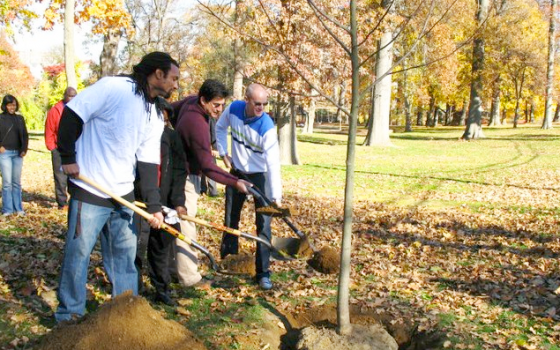In an ideal setting, Philadelphia’s air would be cleaner. There would be more trees and more green space, like up to 42K acres—almost half of the city’s area—more. This, according to a December 2010 Parks and Recreation study on the city’s urban tree canopy. Urban canopy is “a vital asset that reduces storm-water runoff, improves air quality, reduces the City’s carbon footprint, enhances quality of life, contributes to savings on energy bills, and serves as habitat for wildlife,” the authors write. Made possible by an America Recovery and Reinvestment Act grant through the USDA Forest Service’s Northern Research Station, the report found one-fifth of the City of Brotherly Love, less than 20K acres, was covered by green space. Chinatown, North and South Philadelphia have the least amount of greenery, with only 3 percent. The Wissahickon and Pennypack Park neighborhoods boast the highest existing tree canopy at 83 percent and 81 percent, respectively. “Possible areas” refers to locations that are already open fields or vacant lots, or impervious spaces like roofs or asphalt that could be altered to include trees and gardens. In the Girard estates neighborhood, only 8 percent compared to a possible 59 percent tree canopy is utilized. While the study illustrates up to 20K acres of unused potential green space, sadly, that number is not entirely realistic. “Planting new trees on much of this land may not be socially desirable, (e.g. recreation fields) or financially feasible (e.g. parking lots),” the study’s authors advise. “Setting a realistic goal requires a detailed feasibility assessment.”
In the name of expanding our urban canopy, Plant One Million, a new Pennsylvania Horticultural Society initiative aims to plant one million trees across the tri-state area by 2026, according to PHS spokesperson Alan Jaffe. Through a number of programs like Tree Tenders, they hope to increase the region’s tree canopy, which in the 1970s lost millions of trees to development, by 30 percent. “Everyone can plant a tree in their own back yard,” said Jaffe. (If you want to plant a tree on your street, city regulations require you to go through the Parks and Rec Dept., but the yard, if you’re an owner, is fair game.) In addition to the aesthetic and environmental benefits, a “tree in front of your home raises the value of your home by up to 10 percent,” he says. PHS is also encouraging schools and businesses to convert some of their asphalt parking lots and walkways into gardens. Even plants in small pots have their benefits.
It should be interesting over the next 20 years, while we watch how many acres we can really convert into green canopy across the city. (We need a lot of that asphalt to raise taxes for our bungled city budget.) Still, we’re happy to see increased energy and collaboration between civic groups, city and state institutions dedicated to making the green ideal a reality. —-Lou Mancinelli



Leave a Reply